Prompt Engineering Techniques: Top 15+ Shaping AI in 2025
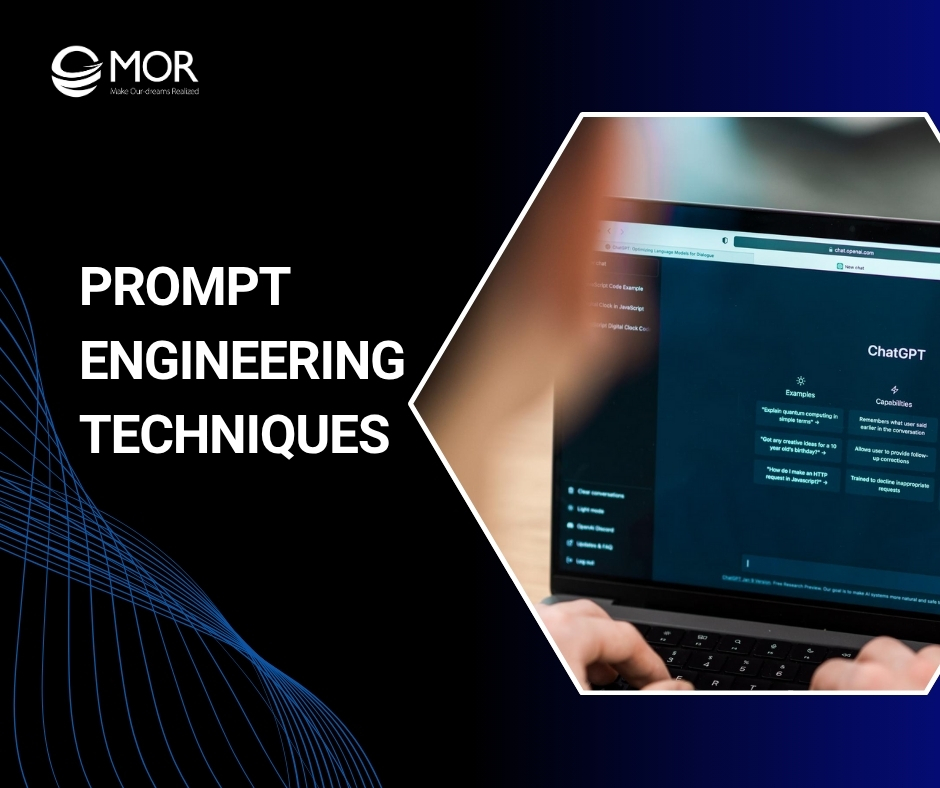
Mastering prompt engineering techniques helps AI deliver accurate, meaningful results instead of random guesses. In this guide, MOR Software shares the most advanced prompt engineering techniques 2025 that empower developers and businesses to build smarter, more reliable AI systems.
What Is Prompt Engineering?
McKinsey estimates that generative AI could add $2.6–$4.4 trillion in value each year, which is why the craft of directing these systems precisely matters so much.
Prompt engineering techniques involve crafting precise instructions that guide generative machine learning models to produce accurate, meaningful results. While AI systems can simulate human thinking, they still rely on structured prompts to deliver relevant and high-quality responses.
In this process, developers carefully select the right phrasing, tone, symbols, and structure to help the AI understand user intent. This combination of strategy and experimentation allows teams to shape how the model interprets and responds to each query.
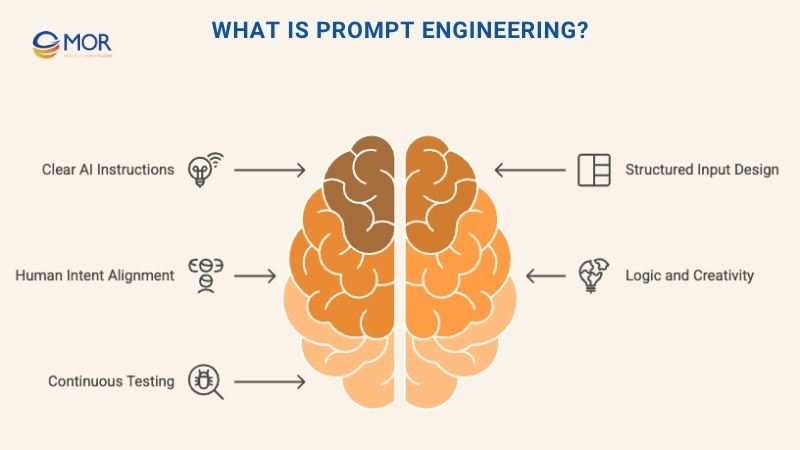
This attention to structure is practical too. Research shows that today’s generative AI automation tools could automate about 60 to 70% of the tasks that take up employees’ time, so even small prompt adjustments can significantly affect overall productivity.
A skilled prompt engineer blends logic with creativity, designing clear and effective instructions that make AI interactions more natural and useful. Through continuous testing and refinement, prompt engineering techniques ensure that generative AI performs consistently and aligns with real-world needs.
Why Is Prompt Engineering Important?
The demand for professionals skilled in prompt engineering techniques has grown rapidly with the rise of generative AI. These specialists act as translators between human intent and machine understanding, helping large language models respond with clarity and precision.
According to IBM’s Global AI Adoption report, 42% of enterprise-level companies are already using AI, while another 40% are testing or exploring it. This growing adoption makes effective prompting more important than.
Prompt engineers design adaptable scripts and reusable templates that allow developers and end users to get the most accurate results from machine learning systems. They test multiple input styles and record the most effective ones, creating a prompt engineering guide that improves results across various use cases.
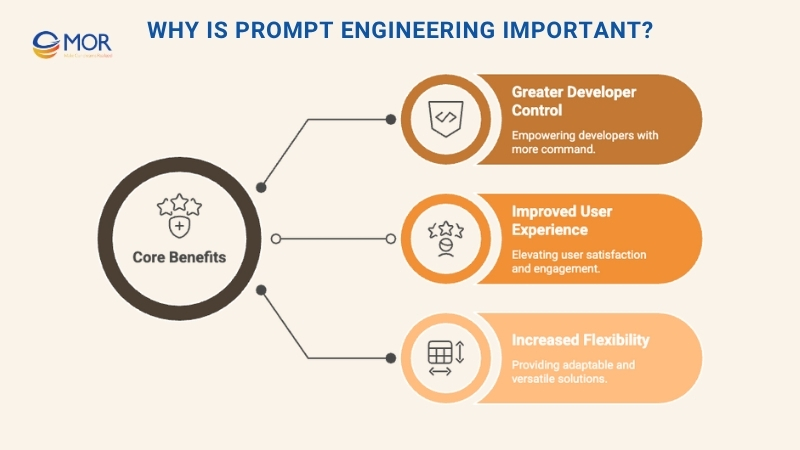
Well-designed prompts make AI systems more focused and context-aware. In practice, developers embed user queries inside structured prompts before sending them to the model.
Take an AI chatbot, for example. When a user types, “Where to buy a shirt,” the application reformulates that input into a detailed instruction like, “You are a retail assistant helping a customer in Alabama find nearby stores selling shirts.” The result is more relevant, accurate, and human-like.
That focus represents where most of generative AI’s business value is expected to appear. Around 75% of its potential impact lies in four main areas: customer operations, marketing and sales, software engineering, and research and development. These are exactly the types of tasks that benefit most from well-designed and thoughtful prompting.
This process shows how prompt engineering techniques make AI application generator smarter, faster, and more reliable for everyday use.
Next, let’s look at the key benefits that prompt engineering techniques bring to modern AI development.
Greater Developer Control
Prompt engineering techniques give developers direct control over how users interact with AI systems. Well-crafted prompts define intent, set boundaries, and establish clarity for the model’s responses. They help the AI interpret user input accurately and deliver results in a structured, readable format.
By shaping these inputs, developers can also prevent misuse or irrelevant requests. For example, in a business AI platform, prompts can restrict users from generating off-topic or inappropriate content, maintaining both professionalism and reliability.
Improved User Experience
With prompt engineering techniques, users spend less time guessing what to type and still get clear, accurate, and relevant results. Well-structured prompts reduce confusion and guide the AI to deliver precise answers on the first try, creating smoother interactions.
They also help balance potential bias that may exist in a model’s training data, leading to fairer outcomes. More importantly, effective prompt engineering techniques allow the AI to understand intent from short or vague requests. For instance, when asked to “summarize this document,” the AI can adjust tone and depth differently for a legal report versus a news article, enhancing user satisfaction and trust.
Increased Flexibility
Prompt engineering techniques give AI systems the adaptability needed to handle various business goals without constant reprogramming. By designing domain-neutral prompts that focus on logic and pattern recognition, engineers make models more scalable and easier to reuse across teams.
This flexibility lets organizations repurpose proven prompts to support multiple workflows or departments, saving time and resources. For instance, a prompt technique can teach an AI automation model to detect inefficiencies in operations using general indicators instead of specialized data. The same structure can then be applied across manufacturing, finance, or HR to uncover performance gaps quickly.
Key Prompt Engineering Techniques
To make AI models perform at their best, prompt engineering techniques use structured methods tailored for specific goals and scenarios. Each approach fine-tunes how an AI interprets questions, manages context, and generates responses that align with user expectations.
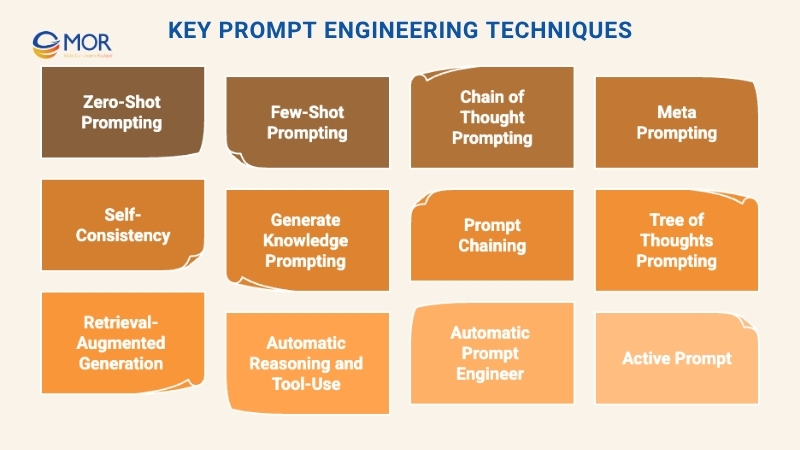
To illustrate the difference between these advanced prompt engineering techniques, consider one shared use case: explaining climate change. The base prompt might be:
Explain the concept of climate change, its causes, and its effects in a way that is easy for everyone to understand.
Every method adjusts this same task in unique ways, some offer detailed guidance, others leave space for creativity or reasoning. The examples below show how these varied strategies help shape AI performance and reveal the depth of prompt computing in real-world applications.
Zero-Shot Prompting
Zero-shot prompting is one of the most basic prompt engineering techniques, where the AI completes a task without any prior examples or contextual hints. It depends entirely on its pretrained understanding to interpret and answer the prompt.
Example prompt:
Explain the concept of climate change, its causes, and its effects in simple terms.
Here, the model generates an answer using only its internal knowledge, without external cues or prior samples. This approach is fast and efficient for straightforward tasks but can sometimes produce inconsistent or shallow results when deeper context is needed.
Few-Shot Prompting
Few-shot prompting improves performance by adding a few sample inputs and outputs directly in the prompt. These examples guide the AI agent frameworks on structure, tone, and expected response quality.
Example prompt:
`Here are some examples of how to explain complex topics:
- Topic: Photosynthesis
- Explanation: Photosynthesis is the process where plants use sunlight, water, and carbon dioxide to create energy and oxygen.
- Topic: Gravity
- Explanation: Gravity is the force that pulls objects toward one another, like how the Earth keeps us grounded.
Now explain: Climate Change.`
Giving these samples, the model learns the desired clarity and tone, making the final output more coherent and consistent with human expectations.
Chain of Thought (CoT) Prompting
Chain of thought (CoT) prompting is one of the most powerful prompt engineering techniques for tasks that require reasoning. Instead of giving a single direct answer, this method guides the AI as a service to think through each stage of a problem step by step, improving both accuracy and logic in the final output.
Example prompt:
Step 1: Define what climate change is. Step 2: Explain the causes of climate change. Step 3: Describe its effects on the planet. Now, follow these steps to explain climate change.
Instructing the AI to follow a sequence, CoT prompting helps it organize information, identify relationships, and present ideas clearly. This structured thinking approach makes complex reasoning tasks easier to handle, showcasing one of the best prompt engineering techniques for analytical precision.
Meta Prompting
Meta prompting takes prompt engineering techniques a step further by asking the AI to create or refine its own prompts before performing a task. This method leverages the model’s built-in reasoning and adaptability, allowing it to shape the best possible instruction for itself.
Example prompt:
Create a prompt that will help you explain climate change, its causes, and its effects in simple terms.
In this case, the model first generates a custom instruction and then follows it to deliver a more relevant, well-structured answer. This reflective process often leads to improved precision and creativity, representing one of the latest prompt engineering techniques 2025 gaining traction in AI development.
Self-Consistency
Self-consistency enhances reliability by letting the model produce several different responses to the same query, then select the most logical or accurate one. This technique minimizes randomness and strengthens reasoning across outputs.
Example prompt:
Provide three different explanations of climate change, its causes, and its effects. Then identify the most coherent and clear explanation.
Through comparison, the AI evaluates its own answers and picks the most consistent version. This method aligns with modern AI prompt engineering guidelines that focus on generating dependable and interpretable results.
Generate Knowledge Prompting
Generate knowledge prompting is one of the more advanced prompt engineering techniques, designed to help AI models think before they answer. The idea is simple: ask the model to gather relevant background information first, then use that knowledge to respond more accurately and in greater detail.
Example prompt:
Before explaining climate change, first list the key scientific principles related to it. Once done, use these principles to explain the concept, its causes, and its effects.
By prompting the AI to recall facts such as greenhouse gases and global warming, it builds a foundation that leads to more informed, factual, and coherent answers. This technique is especially effective for educational or analytical applications that depend on accuracy.
Prompt Chaining
Prompt chaining connects multiple prompt engineering techniques into a logical sequence, where each output becomes the next input. This approach is ideal for complex, multistep reasoning tasks that require structure and continuity.
Example prompt:
What is climate change? Provide a brief definition.
Next prompt:
What are the main causes of climate change?
Next prompt:
What are the effects of climate change on the environment and human life?
Each prompt builds upon the last, allowing the AI diversity to refine its understanding at every step. This method demonstrates how prompt works to break large problems into manageable parts, resulting in clear and comprehensive outcomes.
Tree of Thoughts Prompting
Tree of thoughts prompting is one of the more exploratory prompt engineering techniques, guiding AI models to think in multiple directions before deciding on the best outcome. Instead of following a single line of reasoning, the AI generates several possible paths, weighs their pros and cons, and then chooses the strongest one.
Example prompt:
List three possible ways to explain climate change to a general audience. For each method, describe its advantages and disadvantages. Then choose the best explanation and elaborate on it.
This branching method encourages deeper analysis and produces well-rounded, logical results. It’s often used in decision-making, creative writing, and research settings where varied reasoning adds value.
Retrieval-Augmented Generation (RAG)
Retrieval-Augmented Generation (RAG) combines prompt engineering techniques with real-time data access to create more informed, up-to-date responses. The model retrieves external information and then uses that data to generate accurate answers.
Example prompt:
Using the global temperature datasets from NASA GISS (GISTEMP) dataset on climate science, explain climate change, its causes, and its effects in simple terms.
Integrating retrieval systems, RAG grounds generative AI in factual knowledge, reducing misinformation and improving trustworthiness. This makes it a cornerstone of advanced prompt engineering techniques 2025, especially in data-driven industries like healthcare, finance, and research.
Automatic Reasoning and Tool-Use
Automatic reasoning and tool-use extend prompt engineering techniques by combining AI reasoning with external resources like APIs, databases, or calculators. This enables the model to analyze real data, perform calculations, or fetch external information before generating its response.
Example prompt:
Use the provided climate data to calculate the global temperature rise over the last century, and then explain how this relates to climate change, its causes, and its effects.
Connecting reasoning with tools, the AI vs ML vs DL delivers accurate, data-supported insights. This approach helps developers design intelligent systems capable of solving complex, real-world problems with measurable precision.
Automatic Prompt Engineer
Automatic prompt engineer is a self-improving method where AI systems create and refine their own prompts for better results. This automation helps identify the most efficient phrasing and structure for specific tasks without human trial and error.
Example prompt:
Generate a prompt that will help explain climate change, its causes, and effects. Then use the generated prompt to provide the explanation.
Learning from its own performance, the model continuously enhances output quality and consistency. This method reflects the future of effective prompt engineering techniques, where AI helps refine its own workflow for smarter automation.
Active Prompt
Active prompting is a dynamic approach within prompt engineering techniques where prompts evolve during the interaction. Instead of using one static input, the AI receives follow-up instructions based on its earlier responses, allowing it to refine and expand ideas in real time.
Initial prompt:
Explain climate change, its causes, and its effects in simple terms.
Follow-up prompt:
Add more detail about the causes of climate change, focusing on human activities.
Through this iterative process, the AI improves clarity and accuracy with each step. This adaptability makes active prompting a valuable method for research, learning systems, and interactive applications that require evolving context.
Directional Stimulus Prompting
Directional stimulus prompting (DSP) uses subtle cues to steer an AI model toward a specific tone, emotion, or point of view. It’s one of the advanced prompt engineering techniques that enhances control over the model’s voice and perspective.
Example prompt:
Explain the concept of climate change from an environmentalist’s perspective, focusing on the need for immediate action.
Embedding cues like tone or stance, DSP helps shape responses that align with particular audiences or communication goals, ensuring messages sound intentional and consistent across applications.
Program-Aided Language Models (PALM)
Program-aided language models (PALM) expand the scope of prompt engineering techniques by merging programming skills with natural language reasoning. This integration enhances analytical precision and allows big data machine learning systems to generate actionable code alongside human-readable explanations.
Example prompt:
Write Python code to visualize the increase in global temperatures over time. Then explain how this data relates to climate change, its causes, and its effects.
The model executes both the code and explanation, producing a visual representation of data while interpreting the findings. This hybrid method bridges computational logic and communication, enabling smarter automation in domains like data science and analytics.
ReAct
ReAct (Reason + Act) connects reasoning and decision-making with actions. It allows the AI to analyze information, take logical steps, and perform specific tasks based on its thought process. This is one of the best prompt engineering techniques for tasks that combine understanding with execution.
Example prompt:
Analyze the following climate data and identify key trends. Based on your analysis, explain the concept of climate change, its causes, and its effects.
This approach demonstrates how models can merge critical analysis with actionable responses, making results both intelligent and practical.
Reflexion
Reflexion is an iterative improvement technique where the AI reviews its own output and refines it for better accuracy, tone, or coherence. It’s one of the advanced prompt engineering techniques 2025 gaining attention for applications that demand quality control.
Example prompt:
Here is my first attempt at explaining climate change: [Insert initial output]. Review this explanation and improve it for clarity and accuracy.
Through reflection, the model evaluates its previous response, identifies weak points, and generates a revised version that aligns more closely with the desired outcome. This continuous learning loop ensures higher consistency and reliability in AI-driven communication.
Multimodal Chain of Thought (Multimodal CoT)
Multimodal chain of thought (Multimodal CoT) extends prompt engineering techniques by combining reasoning across multiple input types, including text, images, and audio. This allows AI models to interpret visual or auditory elements alongside written prompts, improving the depth and context of their responses.
Example prompt:
Analyze this infographic on global warming trends, then explain climate change, its causes, and its effects step by step.
Through multimodal reasoning, the AI synthesizes visual data with textual understanding to deliver a richer and more complete explanation. It’s one of the advanced prompt engineering techniques 2025 that strengthens comprehension in data-heavy fields like climate science and medicine.
Graph Prompting
Graph prompting organizes complex data and relationships through graph-based structures. This helps AI models reason about connections between variables, causes, and effects in a more structured and transparent way.
Example prompt:
Using the provided graph of CO₂ emissions over time, explain how it relates to climate change, its causes, and its effects.
By applying this structured reasoning, the AI can identify correlations, patterns, and causality more effectively. Graph prompting demonstrates how prompt works to turn abstract data into actionable insights.
Each of these prompt engineering techniques approaches the same task, explaining climate change, in unique ways. From zero-shot to few-shot and tree-of-thoughts methods, every approach shapes how the AI interprets and presents information. Experimenting with various models, such as ChatGPT, Bard, Claude, or Cohere, helps uncover which method best fits specific goals and tasks.
Common Use Cases for Prompt Engineering Techniques
Prompt engineering techniques are widely applied across AI systems to enhance accuracy, user interaction, and contextual understanding. They help large language models deliver tailored, high-value responses across industries. Below are several common applications.
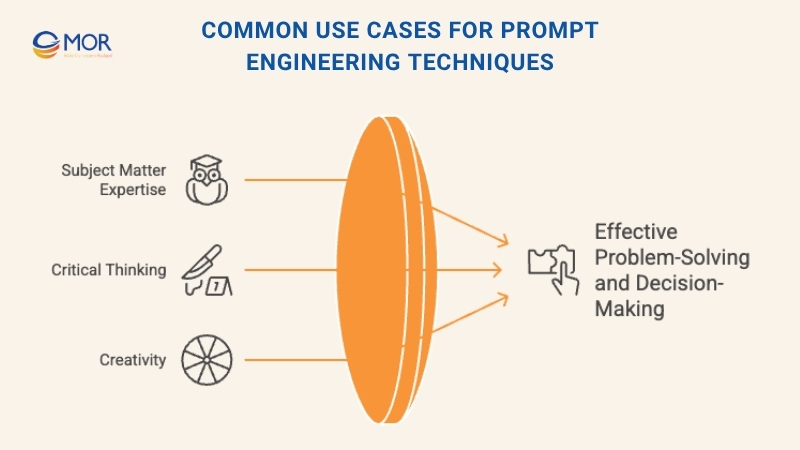
Subject Matter Expertise
In specialized domains, prompt engineering techniques ensure that AI models generate responses aligned with expert-level reasoning. A skilled engineer can design prompts that guide the AI to reference accurate sources, use correct terminology, and frame answers in a way professionals expect.
For instance, AI and machine learning in healthcare, a physician might rely on an AI model trained with prompt engineering guide principles to generate differential diagnoses. After entering symptoms and patient data, the model systematically lists possible conditions and narrows them down based on contextual clues, saving time while maintaining diagnostic accuracy.
Critical Thinking
AI models trained with prompt engineering techniques can analyze complex problems from multiple perspectives and make logical, data-driven decisions. By designing structured prompts, developers help models weigh evidence, assess reliability, and reach well-supported conclusions.
In decision-making situations, for example, a model might be instructed to identify potential options, compare pros and cons, and recommend the most effective course of action. This approach mirrors human reasoning and enhances analytical performance, making it one of the advanced prompt engineering techniques used in business intelligence and research.
Creativity
Creativity thrives when prompt engineering techniques are applied to inspire new ideas, designs, and narratives. Structured prompts can guide AI systems to produce original, imaginative, yet relevant outputs.
A writer, for instance, could ask the AI to propose characters, settings, and themes for a novel, while a designer could prompt it to suggest color palettes that convey a specific emotion. These guided instructions help transform abstract ideas into tangible results, showing how prompt technique can unlock creativity across industries.
Best Practices for Using Prompt Engineering Techniques
Successful prompt engineering techniques depend on clear communication, relevant context, and well-defined expectations. The quality of the prompt directly determines the quality of the AI’s response. Below, we’ll highlight some proven practices for you to follow.
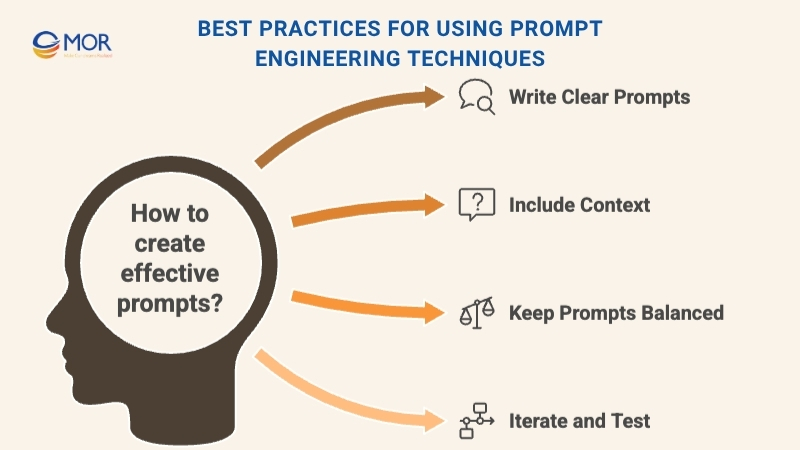
Write Clear and Specific Prompts
Ambiguity confuses AI models. Always define your goals and the exact output you expect. For example, when requesting a short summary of a novel, specify that you want a concise overview instead of a detailed literary analysis. This precision helps the model focus on intent and deliver the right result, reflecting effective prompt engineering techniques in practice.
Include Context in the Prompt
The more context you provide, the more accurate the response becomes. If you’re asking for a list of top 1990s movies, include details like how many titles you need and the preferred format. For instance, instruct the model to display ten titles in a table. Structured guidance gives the model a clear framework, showcasing AI prompt engineering guidelines that lead to consistent, reliable outputs.
Keep Prompts Balanced
A well-designed prompt finds the right balance between detail and clarity. If it’s too brief, the AI might miss context; if it’s overloaded, the system could produce irrelevant or confusing results. The best prompt engineering techniques use straightforward language and concise phrasing, especially when dealing with technical or specialized topics. Simplifying the structure helps the AI understand exactly what’s needed without losing focus.
Iterate and Test Regularly
Prompt engineering techniques work best when refined through experimentation. Creating effective prompts is rarely a one-time process, it takes testing, feedback, and ongoing adjustments to reach optimal accuracy and tone. Try different versions, review outcomes, and fine-tune wording to improve precision and relevance. Following a prompt engineering guide mindset keeps your prompts adaptable and your AI performance consistently strong.
>>> Explore the core steps how to build AI software to design, train, and deploy AI effectively. Follow guide to build, launch, and refine your AI products that deliver lasting value
Challenges When Applying Prompt Engineering Techniques
Even with their growing importance, prompt engineering techniques present real challenges. Writing prompts that consistently deliver precise, factual, and context-aware results isn’t simple, especially when the task requires logical reasoning or subject expertise. Models can still misinterpret intent or produce “hallucinations,” generating incorrect or fabricated information.
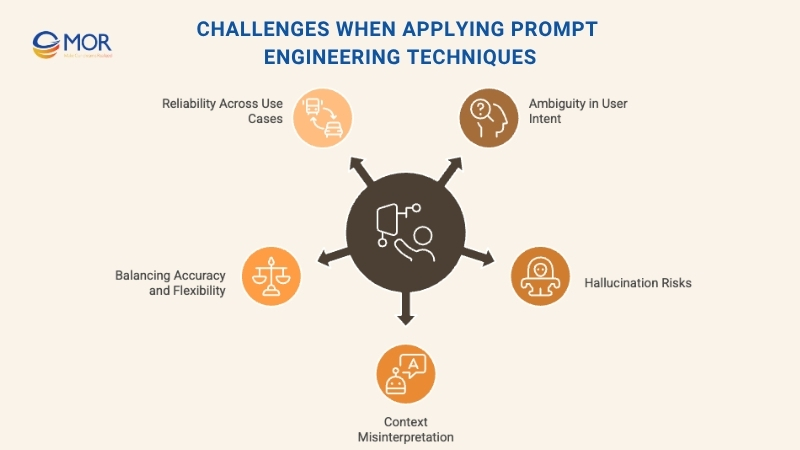
While structured templates and fine-tuning can reduce these errors, achieving reliability across multiple use cases remains a trial-and-error process. Another difficulty lies in balancing general AI capabilities with highly specialized needs. In industries where accuracy is non-negotiable, prompt design must be carefully crafted to align with both human judgment and machine intelligence.
The Future of Prompt Engineering Techniques
The next phase of prompt engineering techniques will focus on smarter, more adaptive language understanding. As AI models evolve, they’ll need fewer instructions to produce accurate, relevant, and context-aware results. This progress will make interactions with AI smoother and more natural, even for highly specialized or creative tasks.
We’re also likely to see emerging tools that automate prompt generation and testing, reducing manual experimentation. These advanced prompt engineering techniques will turn AI systems into self-improving collaborators, capable of learning user intent, refining their own prompts, and personalizing outputs across industries from healthcare to education.
Partnering With MOR Software For Prompt Engineering Solutions
At MOR Software, we apply prompt engineering techniques to design intelligent, explainable, and high-performing AI workflow automation.
Our AI development services specialize in customizing large language models (LLMs) for industries like healthcare, finance, and AI tools for eCommerce, where accuracy, transparency, and adaptability truly matter.
We build scalable machine learning pipelines that combine prompt optimization, model fine-tuning, and real-time data integration. This approach helps our clients create AI systems that learn faster, respond better, and align with business goals.
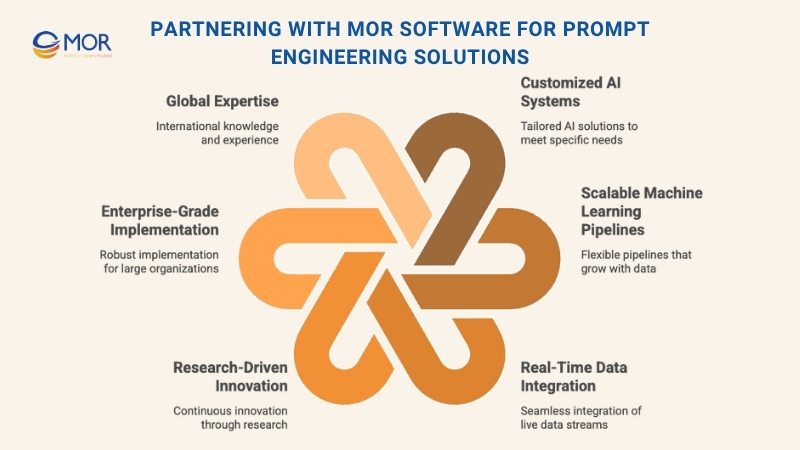
With over 850 completed projects across 10+ countries and recognition as one of Vietnam’s Top IT outsourcing companies in Vietnam, MOR Software continues to bridge research-driven AI innovation with enterprise-grade implementation.
If your organization is exploring prompt engineering for automation, NLP, or predictive analytics, our experts can help transform ideas into reliable, production-ready solutions.
Contact us to discover how we can make prompt engineering work for your business.
Conclusion
Prompt engineering techniques are shaping how AI understands, reasons, and interacts with the world. As models become more advanced, the ability to craft precise, goal-driven prompts will define the next generation of intelligent applications. At MOR Software, we turn these techniques into real business outcomes through scalable, transparent, and industry-focused AI solutions. Contact us today to explore how our experts can help your organization build smarter, more reliable AI systems.
MOR SOFTWARE
Frequently Asked Questions (FAQs)
What are the techniques in prompt engineering?
Prompt engineering includes several effective methods such as Zero-shot prompting, where the AI handles tasks without examples, and Few-shot prompting, which provides a few samples to guide responses. Chain-of-thought prompting helps the model reason step by step, while Meta prompting embeds extra instructions inside the prompt itself. Self-consistency compares multiple reasoning paths to find the most accurate result. Other techniques include Generate-knowledge prompting, Prompt chaining, and Tree-of-thoughts prompting, which expands the AI’s reasoning into multiple directions.
What are the techniques to prompt AI?
Effective prompting starts with using clear and natural language. Provide detailed yet concise instructions, stay conversational, and keep your structure organized so the AI can follow your intent easily. Well-structured prompts reduce errors and improve accuracy.
What are the 5 rules of prompt engineering?
Five important rules shape successful prompt engineering. First, divide complex goals into smaller, manageable steps. Then, connect those steps to form complete results. Identify your key focus areas early, ask clear and targeted questions, and review the AI’s responses to refine future prompts.
Which prompting technique is best?
The most effective method depends on your task. Zero-shot prompting works well for general instructions, while Few-shot prompting is useful when examples guide the model. Chain-of-thought prompting improves reasoning, Meta prompting enhances tone and control, and Self-consistency ensures dependable results
How to get better at prompt engineering?
To improve, set clear goals and give enough context before writing prompts. Use examples where possible, stay specific in what you ask, and test multiple variations. Reviewing results helps refine prompts for better consistency and accuracy over time.
What is advanced prompt engineering?
Advanced prompt engineering involves creating structured and context-rich inputs to guide the AI’s logic. It focuses on handling complex or multi-step problems by combining examples, prior knowledge, and reasoning frameworks for stronger performance.
What are the 4 parts of a prompt?
A complete prompt usually includes four parts: the Role (defines the AI’s perspective), the Task (explains what it should do), the Requirements (adds details or constraints), and the Instructions (guides how the final response should look or sound).
What not to do in prompt engineering?
Avoid vague or overloaded prompts that mix multiple tasks. Don’t assume the AI will infer missing details. Instead, write focused, testable prompts and refine them regularly to prevent inaccurate or confusing outputs.
What are examples of bad AI prompts?
A bad prompt lacks clarity and direction. For example, “Write an email to your boss about the project” is too broad. Without purpose, tone, or details, the AI can’t generate a meaningful result.
What is the best way to think of prompt engineering?
Prompt engineering is the art of designing and refining instructions that help AI systems understand exactly what you want. It requires creativity, logical thinking, and experimentation to produce accurate and relevant responses.
What are the limitations of prompt engineering?
Prompt engineering depends heavily on clear structure. Poorly written prompts can lead to biased or incorrect results, and even well-crafted ones can’t fully control unpredictable AI behavior or ensure perfect accuracy.
How much coding is required for prompt engineering?
You don’t need advanced coding skills to start. If you already know Python or another language, you can learn the basics within hours. Without coding experience, it may take a few weeks to build confidence and apply prompt design effectively.
What is the main challenge of prompt engineering?
The biggest challenge is creating prompts that are clear enough to avoid confusion but detailed enough to guide the AI effectively. Too much ambiguity often leads to off-topic or irrelevant answers, so precision and testing are key.
Rate this article
0
over 5.0 based on 0 reviews
Your rating on this news:
Name
*Email
*Write your comment
*Send your comment
1